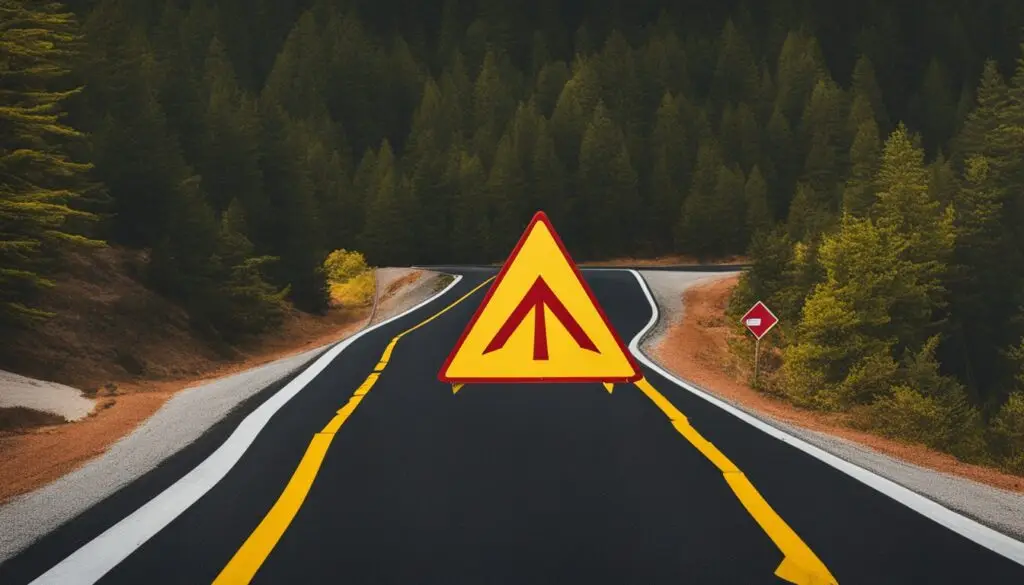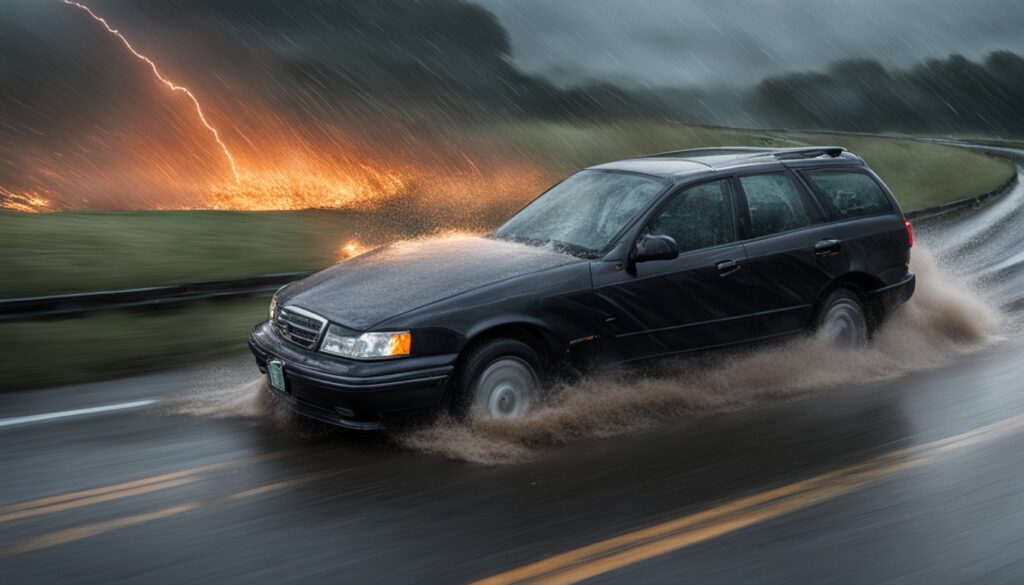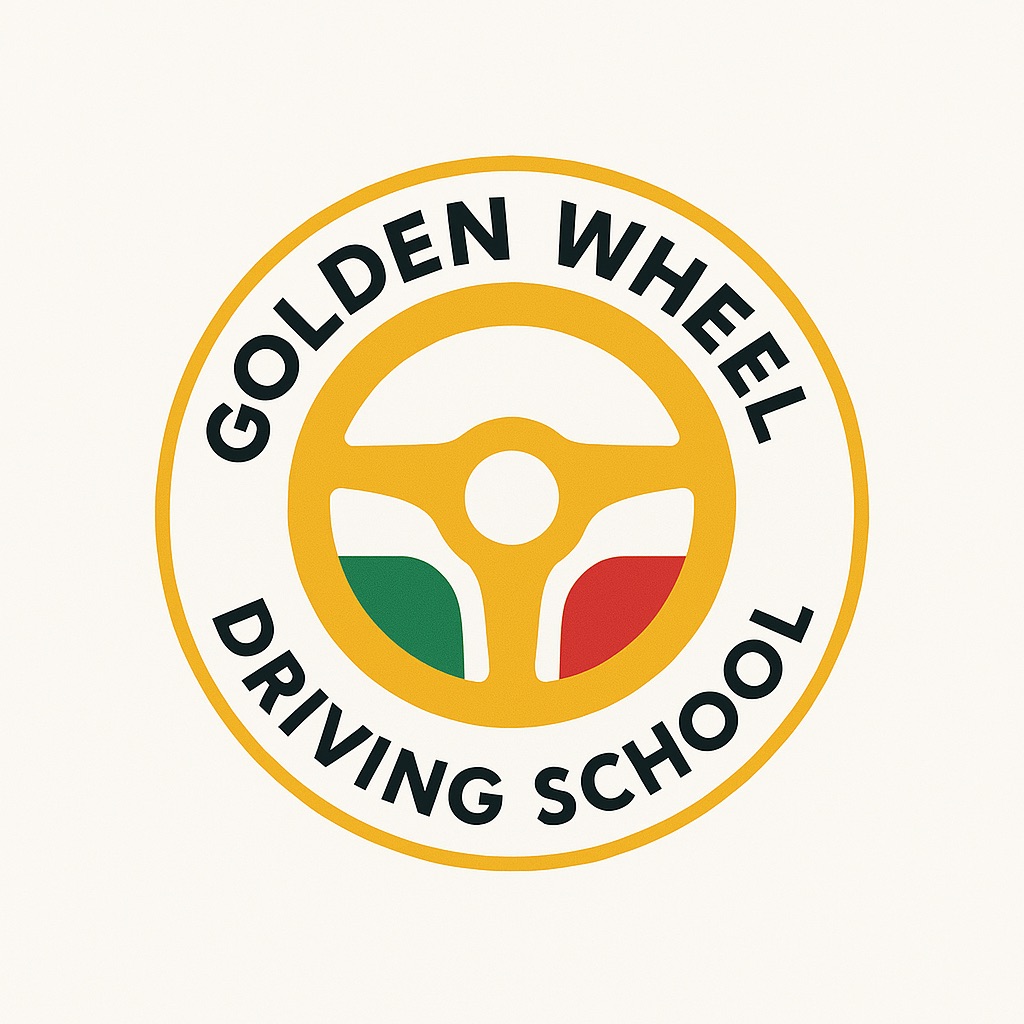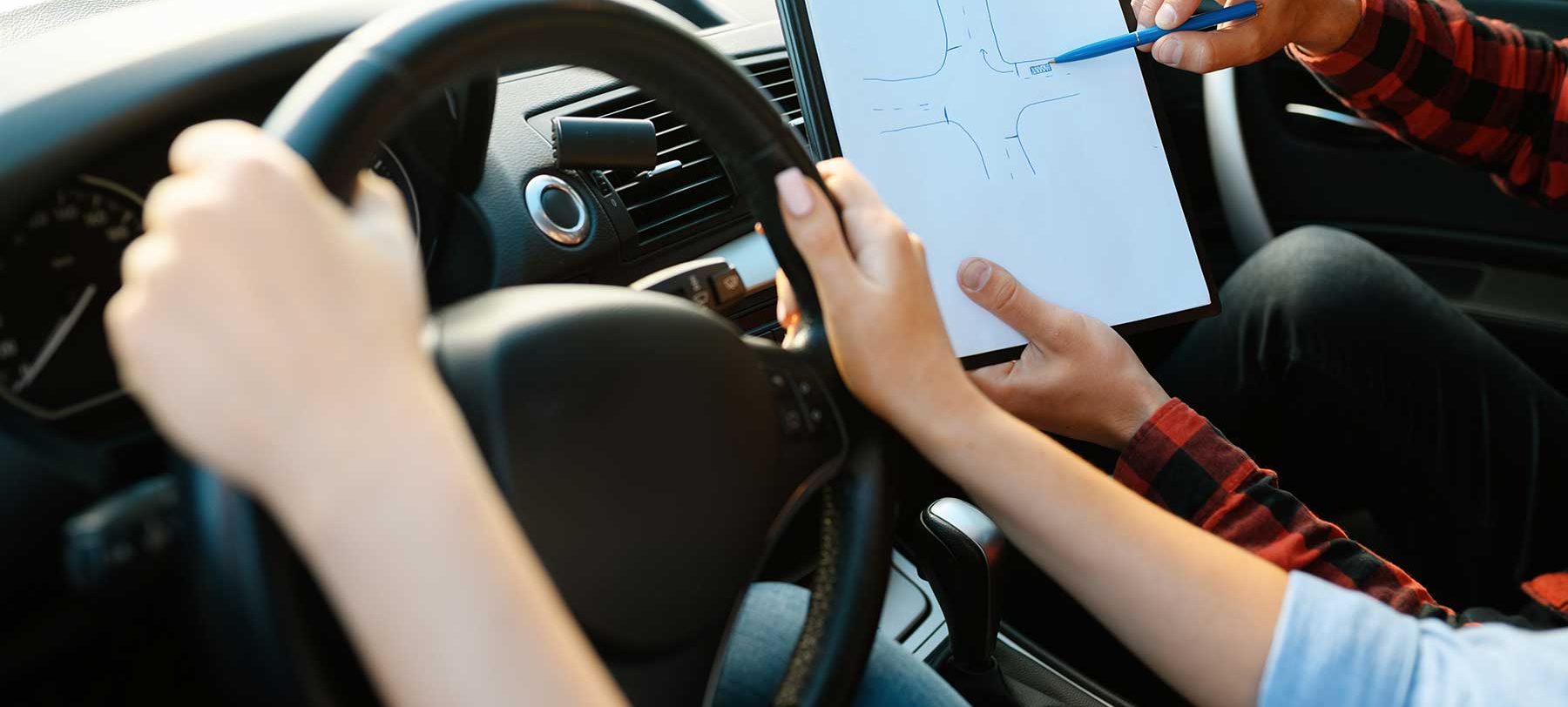Learning to drive for the first time is both exciting and a bit scary. This guide offers 10 key tips to help new drivers feel confident and safe. It covers everything from basic skills to avoiding distractions on the road. These tips aim to make you a responsible and confident driver.
Key Takeaways
- Develop essential driving skills through practice and instruction
- Understand and follow traffic laws and regulations
- Stay focused and minimize distractions while driving
- Embrace the learning journey and build positive driving habits
- Anticipate and react to potential road hazards
Mastering the Basics of Driving
For first-time drivers, learning the basics of driving is key. It helps build confidence and skills for safe road navigation. This guide covers essential driving elements, like seating position, mirror settings, and braking techniques.
Developing Confidence Behind the Wheel
Starting with the basics is crucial for confidence. Adjust your seat, mirrors, and steering wheel for comfort. Learn where all controls are, like the turn signals and windshield wipers.
Practice driving in quiet areas to get better. Focus on smooth acceleration, braking, and steering. This will help you feel more confident.
Understanding Traffic Laws and Signals
Knowing traffic laws and signals keeps you and others safe. Learn about speed limits and right-of-way rules. Pay attention to traffic lights and signs to react quickly.
Following traffic laws reduces accident risks and fines. It’s important for new drivers to know these rules well.
Learning to drive takes time and practice. Be patient and stay focused. With time, you’ll become a skilled and safe driver.
“The key to becoming a confident first-time driver is to start with the basics and practice regularly.”
Staying Focused and Avoiding Distractions
As a first-time driver, it’s key to stay focused and avoid distractions. This keeps you and others safe. Distracted driving is a big cause of accidents. It’s important to start with safe driving habits.
One big challenge for new drivers is not using their phones while driving. Texting, checking social media, or taking calls can take your focus off the road. This is dangerous. To avoid these driving distractions, turn off your phone or put it in the glove compartment while driving.
Adjusting the radio or music can also distract you. It’s good to have nice music while driving, but keep the volume low. This way, you can still hear important sounds like emergency vehicles or horns. Don’t change the radio or music while driving.
Talking to passengers can also distract you. It’s natural to want to chat with your friends or family, but keep your eyes on the road. Ask your passengers to help by reading signs or being careful with their actions.
By following safe driving habits and avoiding driving distractions, you’ll get better at staying safe and making good decisions. The main thing is to keep your eyes on the road, your hands on the wheel, and your mind on driving.
“The greatest weapon against stress is our ability to choose one thought over another.” – William James
| Driving Safety Tips | Avoid Driving Distractions |
|---|---|
|
|
First-Time Drivers: Embracing the Journey
Learning to drive is a journey, not just a goal. For first-time drivers, it’s key to enjoy the learning and build good driving habits. These habits will help you on the road. By learning safe driving and spotting hazards, you’ll get better and feel more sure.
Building Positive Driving Habits
It’s important for new drivers to make good habits. Scanning the road ahead, keeping a safe distance, and seeing obstacles early keep you alert and ready. The more you do these, the easier they become. This will make you more confident and safe while driving.
Recognizing Common Driving Hazards
Knowing and dealing with common driving dangers is also key for new drivers. Hazards can be bad weather, distracted drivers, or sudden road changes. By being ready for these, you can handle them better. This makes you safer on the road.
“The journey of a thousand miles begins with a single step. Embrace the learning process, and you’ll be driving with confidence in no time.”
Getting good at driving takes time and practice. But by enjoying the journey and making good habits, new drivers can drive safely and with more confidence.
The Art of Defensive Driving
Driving can be exciting, but it’s also important to be careful, especially if you’re new to it. Defensive driving is key to staying safe and making smart choices on the road. It means being ready for anything that happens, like sudden lane changes or unexpected stops.
Anticipating and Reacting to Road Situations
Good defensive driving means you can see dangers before they happen and act fast. Always check your surroundings, know where your car is in relation to others, and guess what other drivers might do. This way, you can make smart choices and avoid risky situations.
- Keep a safe gap from the car ahead, so you can stop quickly if needed.
- Look at intersections and blind spots before moving, watch out for cars and people.
- Change your speed and how you drive based on the road conditions, like bad weather or lots of traffic.
Defensive driving is not just about reacting to dangers. It’s also about seeing risks ahead and doing something about them. By learning these skills, you’ll drive more confidently and safely, making the roads safer for everyone.
“The best defense is a good offense. In driving, the best defense is a good defense.”
Maintaining Your Vehicle’s Safety
As a first-time driver, keeping your vehicle safe is key. Regular maintenance helps your car last longer and keeps everyone safe. Checking tire pressure and engine oil levels is crucial.
Checking your tire pressure is vital. Properly inflated tires save fuel, improve handling, and help you brake better. This reduces the chance of accidents. Always check tire pressure once a month and follow the manufacturer’s advice.
It’s also important to check your engine oil level. Low oil can damage your engine and cost a lot to fix. Always check the owner’s manual for when to change oil and what type to use.
Don’t ignore warning lights or mechanical issues. These signs can make your car unsafe and affect its performance. Fixing problems quickly keeps your car safe and in good shape.
Proper maintenance is key to safe driving and a long-lasting car. By following these tips, you’ll enjoy driving more and stay safe on the road.
Understanding Road Signs and Markings

Learning to navigate roads as a new driver can feel overwhelming. But, knowing about road signs and markings is key. These signs and markings give you important info to stay safe and make smart choices on the road.
Navigating Different Driving Conditions
Driving on highways, at intersections, or in bad weather each presents its own set of challenges. Learning about different road signs helps you handle these situations safely. It keeps you and others safe.
There are many types of road signs, like stop signs and speed limit signs. These regulatory signs tell you the rules of the road. Warning signs alert you to dangers or changes ahead, helping you get ready.
Informational signs show directions, distances, and places of interest. They help new drivers find their way in unknown areas. Knowing what these signs mean is key to driving safely and wisely.
Pavement markings are also important for drivers. They show traffic flow and what driving behaviors are expected. Solid and dashed lines, crosswalks, and lane dividers give you clues about how to drive.
| Road Sign Type | Purpose | Examples |
|---|---|---|
| Regulatory Signs | Indicate the rules of the road that must be obeyed | Stop signs, speed limit signs, one-way signs |
| Warning Signs | Alert drivers to potential hazards or changes in road conditions | Curve ahead, animal crossing, slippery when wet |
| Informational Signs | Provide directions, distances, and other helpful information | Highway exit signs, distance markers, points of interest |
Learning about road signs and markings helps new drivers feel more confident. It prepares them for different driving situations. Paying attention to these signs is vital for road safety for beginners. It makes driving safer and more enjoyable.
Building Confidence on the Highway
Driving on the highway can feel scary for new drivers. But, with the right skills and mindset, you can become confident. This guide will teach you how to merge and change lanes smoothly. It will help you feel more comfortable on the open road.
Mastering Merging and Lane Changes
To drive confidently on the highway, learn to merge and change lanes well. Always check your mirrors and blind spots before you move. Keep a steady speed and smoothly move into the new lane when it’s safe.
Also, keep a safe distance from the car in front. Keep at least three seconds back to have time to react. This keeps you safe and in control.
Developing Confidence Through Practice
Practice is key to getting better at highway driving. Drive on the highway often, slowly increasing your speed. Get to know the highway you’ll be on, including exit ramps and lane setups.
Building confidence takes time. Be patient and ask for help if you need it. With practice and effort, you’ll become a confident highway driver.
| Highway Driving Tip | Benefit |
|---|---|
| Check mirrors and blind spots before merging or changing lanes | Enhances awareness and safety |
| Maintain a safe following distance | Allows for better reaction time and braking |
| Gradually increase highway driving experience | Builds confidence and skill over time |
“The highway is where you really get to test your driving skills. With practice and patience, you’ll be navigating those lanes like a pro in no time.”
Handling Emergencies on the Road

Even the most skilled drivers can face unexpected emergencies on the road. As a new driver, it’s key to be ready and know how to act calmly and effectively. This section will teach you how to handle emergencies like sudden tire blowouts, losing control, and collisions.
Responding to Tire Blowouts
A sudden tire blowout can be shocking and risky. If this happens to you, stay calm and follow these steps:
- Slowly take your foot off the gas and press the brakes gently, avoiding sudden moves.
- Guide your car to the side of the road, keeping it straight as you can.
- Once you’re off the road safely, turn on your hazard lights and pull over to a safe spot.
- Call for roadside help or follow your car’s emergency steps.
Regaining Control in a Skid
If your car starts to skid, act fast and decisively to get back in control. Here’s what to do:
- Remove your foot from the accelerator and avoid hard braking.
- Steer towards where you want the front of your car to go.
- Once stable, apply the brakes slowly to slow down.
Responding to a Collision
If you’re in a collision, focus on keeping yourself and others safe. Here’s what to do:
- Stay calm and turn on your hazard lights.
- Call emergency services if someone is hurt or if cars are blocking traffic.
- Try to move your car to a safe spot, turn off the engine if you can.
- Check the damage and swap insurance details with the other driver(s).
- Take photos and notes of the incident, and report it to your insurance company.
Handling emergencies on the road means staying focused, calm, and following safety steps. Being prepared and practicing these tips will help you handle unexpected situations safely and keep everyone on the road secure.
| Emergency Situation | Recommended Response |
|---|---|
| Tire Blowout | Slowly ease off the accelerator, gently apply the brakes, and steer the vehicle to the side of the road. |
| Vehicle Skid | Remove your foot from the accelerator, steer in the direction you want the front of the vehicle to go, and gently apply the brakes. |
| Collision | Stay calm, turn on hazard lights, call emergency services if needed, move the vehicle to a safe location, and document the incident. |
“The most important thing is to stay calm and focused in an emergency situation. Panicking will only make the situation worse.”
Conclusion
Becoming a skilled and confident driver takes time, practice, and a commitment to continuous learning. This article has shared tips and strategies for first-time drivers. It aims to help them navigate roads safely and with confidence.
We covered the basics of driving and traffic laws. We also talked about staying focused and avoiding distractions. These insights give new drivers a solid foundation to build on.
By embracing defensive driving and keeping their vehicles in good shape, first-time drivers can start their journeys well-prepared. The road to becoming a confident driver is ongoing. Stay alert, keep practicing, and always put safety first.
With dedication and a willingness to learn, first-time drivers can handle any situation on the road. Let’s make the roads safer for everyone by embracing this journey together.







